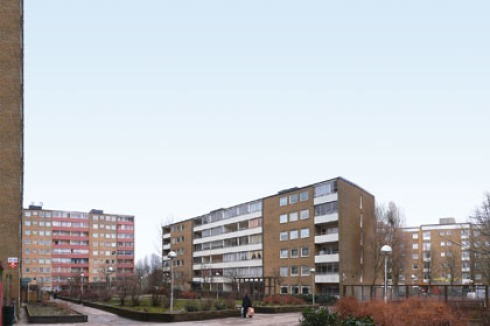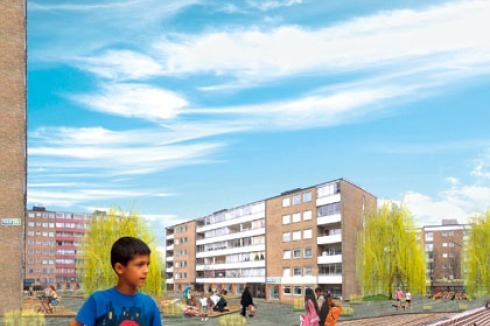Redevelopment Landsfiskalen in the Rosengård-Quarters
Text: Wærn, Rasmus, Spånga (Schweden)
-

Foto: Kristian Skovbakke Villadsen
Foto: Kristian Skovbakke Villadsen
-

Rasmus Wærn discovers in Malmö a new approach in dealing with the prefabricated building neighbourhoods that had been erected in the 1960s in the framework of the “Million Programme”. The already condemned city district of Rosengård was defended by its residents and is now being redeveloped.
There is an air of ease in the renewed part of Rosengård. Not that I felt frightened in the environment, but the atmosphere here was something else. Old women wearing krechifs chatting in cosy corners; fancy playgrounds and most of all: very neat and tidy. This was not the “plattenbau” area I expected.
The cities of Europe has to be places that every inhabitant, native or else, feels proud of. This is the greatest challenge that architecture and urbanism faces today. The more difficult the conditions, the more important the task. The city of Malmö has the largest, the most declined, and the most stigmatized plattenbau area in Sweden. “Rosengård” from 1967-72 has become an icon for high unemployment, poor integration and crime. Even if much of this is true – in “Herrgården”, a part of Rosengård, only 17% have jobs, 98% of the tenants have a foreign background and riots tries to make the place a warzone – Rosengård is a huge urban district where an immense power can be mobilized. The question is how.
In 2006 did the public housing company MKB purchase the most declined part of Rosengård, “Landsfiskalen 1 & 2”. Not because it was a good deal – it was necessary. The decay had to be stopped, and this did not end with the buildings. An intense work together with the inhabitants to pinpoint the deficiencies in the area began, which resulted in a number of improvements; from traditional refurbishment to help with children’s homework.
Gehl architects from Copenhagen was immediately contracted when the remake was initiated. Not primarily for their design skills, but for their behaviouristic. MKB asked for more life between buildings. But what began as a minor refurbishment soon turned into a strategy for the outdoor spaces in Rosengård and its connections to the rest of Malmö, as well as to the entire Örestad region. Their vision states the truths that needs to be said again and again: Rebuild Rosengård to a place with greater spatial diversity, with more multiple connections to the city and with a hierarchy in the outdoor spaces that is easily understood. The operation from MKB was more hands-on: After long and exigent interviews with the tenants (there are 110 different nations in Rosengård) a site-specific agenda emerged. This involved a remake of the outdoor spaces, following the plan from Gehl architects, but also a management that looked into every family’s specific need, whether this was overcrowding, unemployment, or boring free-time – the landlord would do something about it.
In order to raise the status of the area and to restore their twisted self-image, it was crucial that the project did not end in words and reports, but with immediate physical changes. The preparations took their time – two hours sessions with each family and long charettes for the outdoor spaces, but it worked. Except from the outdoor makeover (to program all generic spaces is one of Gehls emblematic theses), new solutions for waste management and new premises for small enterprises in connection with the flats, the tenants has made the successful turnover themselves.
For every complex problem there is always a quick solution that does not work. The more radical suggestions from Gehl architects have not been executed, such as a new urban pattern, which would take both demolition and construction. The size and shape of the houses still mirrors the technocrazy side of the prefab movement, but changes that follow Gehl’s pattern language are coming up; a commuter train that will connect Rosengård with Copenhagen, and a new local centre for example.
But the long-term strives in the Landsfiskalen block shows that improvements in the architecture are not sufficient when it comes to cure a depression. It takes both money and engagement to recall the optimism that the 1960’s once represented. If it works, a shift in the self-image of Europe’s suburbs will be of much greater significance than the last decades hunt for a Bilbao-effect. The Malmö-effect can be described by staircases decorated with children’s mosaic, elderly chatting comfortably by the entrance but most vividly perhaps by the action taken by the people in the houses when a mob from the neighbourhood showed up. Everybody went down to protect “their” environment against the vandals. Nobody’s gonna burn our homes!
x
Bauwelt Newsletter
Immer freitags erscheint der Bauwelt-Newsletter mit dem Wichtigsten der Woche: Lesen Sie, worum es in der neuen Ausgabe geht. Außerdem:
- » aktuelle Stellenangebote
- » exklusive Online-Beiträge, Interviews und Bildstrecken
- » Wettbewerbsauslobungen
- » Termine
- » Der Newsletter ist selbstverständlich kostenlos und jederzeit wieder kündbar.
Beispiele, Hinweise: Datenschutz, Analyse, Widerruf
0 Kommentare